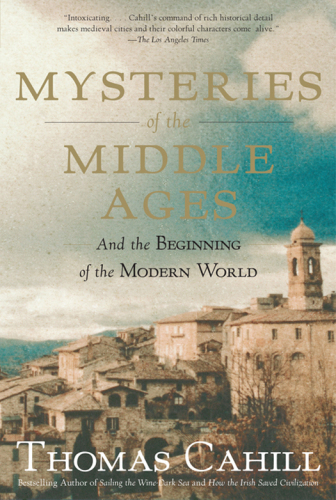
Mysteries of the Middle Ages
And the Beginning of the Modern World
کتاب های مرتبط
- اطلاعات
- نقد و بررسی
- دیدگاه کاربران
نقد و بررسی

August 28, 2006
Cahill's latest engaging romp through pop intellectual history (after Sailing the Wine-Dark Sea
) focuses, despite the subtitle, not on fringe cults, but on the mainstream of medieval Roman Catholic thought. Instead of obscurantist dogma, he finds a ferment of implicitly progressive ideas that laid the groundwork for modernity. The veneration of the Virgin Mary, he contends, prompted a boost in women's status, exemplified by the mystic nun Hildegard of Bingen, who gained public status and power as a spiritual figure. The papacy's claim of spiritual authority independent from temporal power contained the seeds of modern notions about the separation of church and state, democracy and the legitimacy of political dissent. And the perennial head scratching over the doctrine of transubstantiation, he argues, stimulated the beginnings of both empirical science and artistic realism. Cahill's treatment is more impressionistic than systematic, and built around lively profiles of iconic medievals like Abelard and Héloïse, Francis of Assisi and Giotto, whose paintings get a long, lavishly illustrated exegesis. The author wears his erudition lightly and leavens his writing with reader-friendly anachronisms, likening Hildegard to blues chanteuse Bessie Smith and calling the Franciscans "the world's first hippies." The result is a fresh, provocative look at an epoch that's both strange and tantalizingly familiar. Photos. Color illus. throughout.

January 29, 2007
Cahill nimbly presents the highlights—and lowlights—of Europe during the Middle Ages in this well-executed romp through history. A skilled narrator of his own work, Cahill brings enthusiasm and passion to the story (especially when describing the peccadilloes of Eleanor of Aquitaine and the steamy affair of Abelard and Héloïse). He is particularly impassioned, even shrill, when comparing the folly of the avaricious Second Crusade with what he sees as the disastrous contemporary war in Iraq, asserting that both wars were invented by leaders with little understanding and even less wisdom. Cahill also emerges as a credible singer, producing competent and tuneful a cappella renditions of the hymns of both Hildegard of Bingen and Thomas Aquinas. The abridgment is seamless in the first few chapters, but then a bit more pronounced as the book draws to a close; the chapter on Giotto feels rushed. Aside from a few awkward mispronunciations, this audio book will delight listeners interested in the great stories of medieval times. Simultaneous release with the Nan Talese
hardcover (Reviews, Aug. 28).

October 15, 2006
Cahill ("How the Irish Saved Civilization") continues his history of Western civilization with this volume, in which he attempts to show how the Catholic Middle Ages laid the groundwork for many of the attractive features of today's world, such as the elevation of women's status and our reorientation toward the natural world. He focuses on a few great figures but even so has little insightful to add. Though an engaging writer, Cahill is an appallingly bad historian. He compares the medieval nun Hildegard of Bingen to blues singer Bessie Smith (arguing that Hildegard's lyrics display a spiritualized eroticism) and to the woman in bondage in "The Story of O", referring also to "Desperate Housewives" and "Sex and the City" (This was one loose sister). He compares Dante to James Joyce because both were exiles infatuated with their mother cities. He characterizes World War I's Battle of Gallipoli as a confrontation between]Islam and the West. Throughout, he tramples history into a muddled paste of great figures and exalting moments, ignoring nuance or exception. He concludes with a five-page diatribe against sycophancy and buggery in today's Church. The footnotes don't inform much; the bibliography omits essential scholarship (e.g., R.W. Sothern on medieval humanism, Roberto Lopez and Lauro Martines on Renaissance humanism). It is difficult to conceive of an audience that would benefit from reading this silly and superficial book. [See Prepub Alert, "LJ "6/1/06.]"DavidKeymer, Modesto, CA"
Copyright 2006 Library Journal, LLC Used with permission.

























دیدگاه کاربران